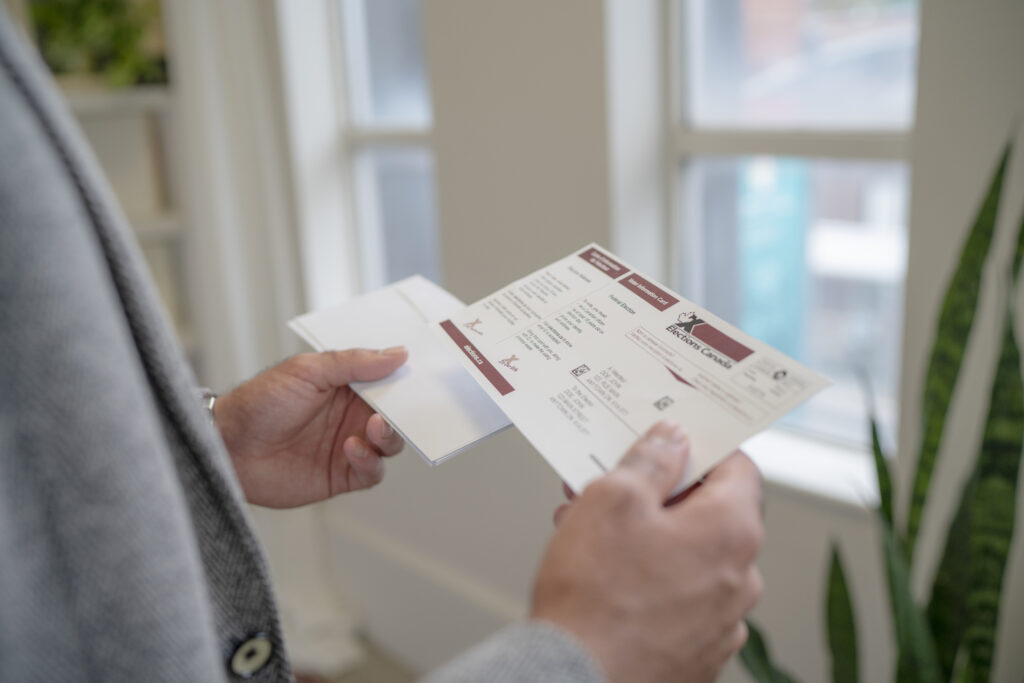
Listen to the whole story here:
To help prepare for the federal election, On The Record has put together an explainer of key facts you need to know.
The basics
This year’s electoral map will include the new 343-seat House of Commons—which is a change of five more than the previous federal election back in 2021. One new seat is out of Brampton, one more out of Vernon, B.C., while Alberta will gain three new seats.
Each seat represents a riding in Canada, an electoral district where, on election day, citizens over the age of 18 will be voting for a Member of Parliament (MP). Candidates can run in affiliation with a certain party or as independents. The elected winner then represents that riding in Parliament until the next election.
There are several levels of governance in Canada: municipal, provincial/territorial and federal. The prime minister (PM) and their cabinet, the Senate (appointed by the PM) and the House of Commons together create, approve and implement federal legislation. The House of Commons is made up of MPs from all over Canada. Once appointed, the prime minister selects a number of confidential advisers, usually from among the elected members of Parliament belonging to the governing party, who are made members of the Privy Council and then sworn in as ministers. Collectively, they are known as the cabinet, and are each responsible for individual portfolios or departments, usually assisted by other members of Parliament who have been appointed as parliamentary secretaries.
If in a general election, a party wins a majority of the seats in the House of Commons, they will go on to form a “majority government,” with their leader becoming the prime minister. A majority government forms when a party wins at least 174 out of a possible 343 seats. However, if no party wins a majority of the seats, instead the party that won the most seats will form what is called a “minority government.” The leader of the party with the most seats then becomes PM.
Currently, Canada is under a minority government, which means the governing party was unable to win over 170 seats (out of the total number of seats in 2021, which was 338) in the House of Commons. Minority governments where no party wins more than half the available federal seats, are quite common in Canada in the 21st century. We’ve been governed by minority governments 13 times since 1921 — six Conservative and seven Liberal, including our most recent government.
The parties
Sixteen parties ran a candidate in the last Canadian federal election, according to Elections Canada, but only five of them currently hold seats in the House of Commons. Each party has a different platform and focus, according to Peggy Nash, an instructor with the Women in The House program at Toronto Metropolitan University and a former MP for the Parkdale-High Park riding in Toronto (2008-2015).
Justin Trudeau, the previous leader of the federal Liberal party, prorogued parliament (terminated the current session of parliament) and announced he was stepping down at the beginning of this year. At prorogue, the Liberals held 153 seats in Parliament, the Conservatives held 120, the Bloc Québécois held 33, and the New Democratic Party (NDP) held 24.
The Conservative Party currently holds the position of the official Opposition, having won the second-most seats in the last general election and will be led by Pierre Poilievre (MP for Carleton) in the upcoming election.
All 33 seats held by the Bloc Québécois can be found in the province of Quebec. The party has generally advocated for Quebec’s interests and independence.
The NDP is led by Jagmeet Singh and according to Nash, who ran as an NDP when she was an MP, the party fights for collective solutions and the support of social programs. “They’d be very strongly pro human rights, pro immigration, pro jobs, protecting workers.”
The Green Party holds two seats in the current Parliament and does not hold official party status (which requires a minimum of 12 seats in the House of Commons).
Three seats are held by independent candidates and the remaining three are vacant.

The Liberals’ leadership race
“This country deserves a real choice in the next election and it has become clear to me that if I’m having to fight internal battles, I cannot be the best option in that election,” Trudeau said in his resignation press conference on Jan. 6, leading to a leadership race for the federal Liberal party that culminated on Sunday, March 9.
Mark Carney won the leadership contest by a large margin. Born in the Northwest Territories and raised in Edmonton, Carney is the former governor of the Bank of Canada. In 2013, he shifted to leading the Bank of England and in 2019 began serving as the UN Special Envoy for Climate Action and Finance.
Former Canadian Deputy Prime Minister Chrystia Freeland came in a distant second in the leadership race for the Liberal party. Freeland surprised many by resigning her cabinet role in December, after holding positions as the minister of finance, minister of intergovernmental affairs, and minister of international trade.
Karina Gould, who got 3.2 per cent of the vote in the leadership race, has served as an MP for Burlington since 2015 and has been a member of Trudeau’s cabinet since 2017 as well as a former House leader. She was the youngest serving female cabinet minister and graduated from Montreal’s McGill University and the University of Oxford in England.
Frank Baylis came in fourth in the leadership race, and is an entrepreneur, engineer and human rights advocate and served as MP for Pierrefonds-Dollard from 2015 to 2019, according to the leadership page. He was a founding member of the Parliamentary Black Caucus, Chair of the Canada-United Kingdom Inter-Parliamentary Association, founder of For the Children and Executive Chairman of Baylis Medical Technologies.
How an election is called
Canada’s constitution says, “No House of Commons and no legislative assembly shall continue for longer than five years from the date fixed for the return of the writs at a general election of its members.” In 2007, an amendment referred to as the fixed date amendment was added to the Elections Act that says, “a general election must be held on the third Monday in October in the fourth calendar year following polling day for the last general election.”
This sets up the next fixed date for a general election as Oct. 20, 2025, but with the change in Liberal leadership, it is likely to come earlier, says York University Politics Professor Emeritus Robert J Drummond. “If it were done right quickly, the date would be sometime in the late spring or early summer.”
An early election is possible because Canadian prime ministers are empowered to ask the Governor General to dissolve Parliament at any time (the Governor General can decline, as Lord Byng did in 1926 in the King-Byng crisis). For example, the country’s most recent general election held in September 2021 was the result of Trudeau asking Gov. Gen. Mary Simon to call an election. While this power held by Canadian prime ministers is somewhat controversial and not explicitly defined in our constitution (hence it is a convention), many agree it is necessary under our Westminster-style parliamentary government, which requires the government of the day to always have the support of the House of Commons to ensure democratic legitimacy.
There are two ways the federal election could be called. The first is for the new Liberal leader and prime minister to call one themselves by meeting with the Governor General. If this does not happen, both Nash and Drummond agree it is likely the Conservatives will put forward a vote of no confidence. If passed, an election would be called sooner than its fixed date. Alternatively, the governing Liberals could try and pass an item through the House that is considered a “confidence vote,” where all parties acknowledge that the passage or failure of the item speaks to the House’s support for the current government. An example of this would be if the Liberals attempted to pass their 2025 budget before going to the polls, as budgets are always considered confidence votes.
A vote of no confidence is a vote where an MP can draft a motion to demonstrate that the current government no longer has the confidence or support of the House of Commons. If a majority of the MPs vote in favour, as they did in 2011 with Conservative PM Stephen Harper, the constitutional convention kicks in. Then the sitting PM will go to the Governor General and ask them to call an election. It is also possible for the Governor General to ask different party(s) and leader(s) to form a government from the existing MPs if they believe that the new government will be able to survive a no-confidence vote. This happened in 1926 for the Arthur Meighen administration.
The Canada Elections Act states that an election period must be at least 37 days and no more than 51. Election day will almost always take place on a Monday, hence it would be between 36 and 50 days after an election is called, Elections Canada told OTR in an emailed statement.
Voting Day
The voting period varies depending on the way individuals choose to vote, but generally advance polls take place on the Friday to Monday, the week prior to election day, Elections Canada’s emailed statement reads. Special ballots can be placed from the time an election begins to six days before election day at 6 p.m. Day-of voting times vary depending on ridings.
Though the parties have not yet released their platforms for this year’s federal election, Nash says it’s important to look for an MP that represents your political interests. “It matters who you want to be your voice,” Nash said.
Election misinformation
Elections Canada said via email it manages the spread of misinformation by monitoring the information environment inside and outside the election. This includes incidents that could hinder the operation of a general election, the sharing of inaccurate information on electoral processes and social media accounts that try to impersonate Elections Canada.
“With more information readily available than ever before, it can be difficult to determine what is accurate and what is inaccurate,” Elections Canada said in the emailed statement. “The spread of inaccurate information, especially during an election, can be harmful and impact electors’ trust in the integrity of the election.”
They added that they run a multimedia campaign prior to and during elections and place all media communications in a repository. Elections Canada also launched a resource to help Canadians check for information they come across regarding Canada’s federal electoral process called ElectoFacts.
Voter Turnout
Voter turnout has steadily decreased for youth aged 18 to 25 years old since 2015, especially for first-time voters, according to Elections Canada’s Voter Turnout Dashboard.
“I know it might seem cool to think in a globalized world that elections don’t matter anymore, that politicians are all the same. But they are not,” Nash said. “People are not all the same and the issues that people work for and fight for are not the same.”
She added that younger individuals have a greater stake in the outcome of elections.
“I’m older, I don’t know how long I’ll be around. But for a person in their 20s…it’s the country you’re going to live in for a long time,” she said.

